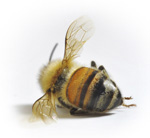03
Aug
Bee-Toxic Pesticide with Some Banned Uses in Oregon Found in Bees Killed There
(Beyond Pesticides, August 3, 2015) Oregon state investigators found lethal levels of a banned, bee-toxic insecticide in the systems of dead bees discovered last month in downtown Portland. The Oregon Department of Agriculture released results last week of investigations into the June 26 bee deaths near Pettygrove Park, as well as two other nearby bee die-offs in mid-June. Dale Mitchell, pesticides program manager for the agriculture department, told The Oregonian that the bees received a dose of imidacloprid, a neonicotinoid chemical that has been linked the global decline in bee populations, more than two-and-a-half times the highly lethal level set by the U.S. Environmental Protection Agency (EPA).
 The Oregonian previously reported about the Pettygrove incident, in which Portland law student Corinne Fletcher stepped outside her doorstep to find countless bumblebees dead or dying on a walkway leading into the park. In that case, as well as the two others just blocks south the park, the bees had been feeding on the nectar of linden trees.
The Oregonian previously reported about the Pettygrove incident, in which Portland law student Corinne Fletcher stepped outside her doorstep to find countless bumblebees dead or dying on a walkway leading into the park. In that case, as well as the two others just blocks south the park, the bees had been feeding on the nectar of linden trees.
It has been illegal to use imidacloprid on linden trees since February, when the Oregon Department of Agriculture banned it after a spate of mass bee deaths involving bumblebees that had been feeding on linden trees treated with neonicotinoids. Along with the Pettygrove Park die-offs, there have been seven separate  bumble bee incidents  in Oregon related to the application of neonicotinoids on trees since June 2013, documented by the state’s Department of Agriculture. Six of those incidents occurred in the greater Portland area.  The ban extended to dinotefuran, clothianidin and thiamethoxam, three other insecticides in the same class.
Neonicotinoids  affect the central nervous system of insects, resulting in paralysis and eventual death. These pesticides have  consistently been implicated  as a key factor  in pollinator declines, not only  linked to acute exposure and  immediate bee deaths, but also sublethal exposure that adversely affects  bee reproduction, navigation, and foraging. The science has become increasingly clear that pesticides, either working individually or synergistically,  play a critical role  in the ongoing decline of honey bees. Pesticide exposure can impair both detoxification mechanisms and immune responses, rendering bees more susceptible to viruses, parasites, and other diseases, and leading to devastating bee losses.
Through interviews with the owners and managers of the property where the bees died of lethal insecticide doses, investigators determined the chemical applications happened before the ban took effect. The area has been a hot spot of bee death in recent years. In addition to this year’s incidents, the agency received reports of dead bees in the same vicinity in 2014 and 2013. Â The fact that such a dramatic poisoning event occurred long after the application of neonicotinoids stresses the dangers of these persistent systemic insecticides
Along with the lethal dose of imidacloprid in the Pettygrove bees, investigators found clothianidin, another banned neonicotinoid, in their systems. At another death scene two blocks south and three days earlier, investigators again found imidacloprid. Investigators also found traces of chlorothalonil, a fungicide.
Beyond Pesticides has long advocated a regulatory approach  that prohibits high hazard chemical use and requires alternative assessments. We suggest an approach that rejects uses and exposures deemed acceptable under risk assessment calculations, and instead focuses on  safer alternatives that are proven effective, such as  organic agriculture, which, of course, prohibit the use of neonicotinoids. See how  you can  Bee Protective.
Source: The Oregonian
All unattributed positions and opinions in this piece are those of Beyond Pesticides










